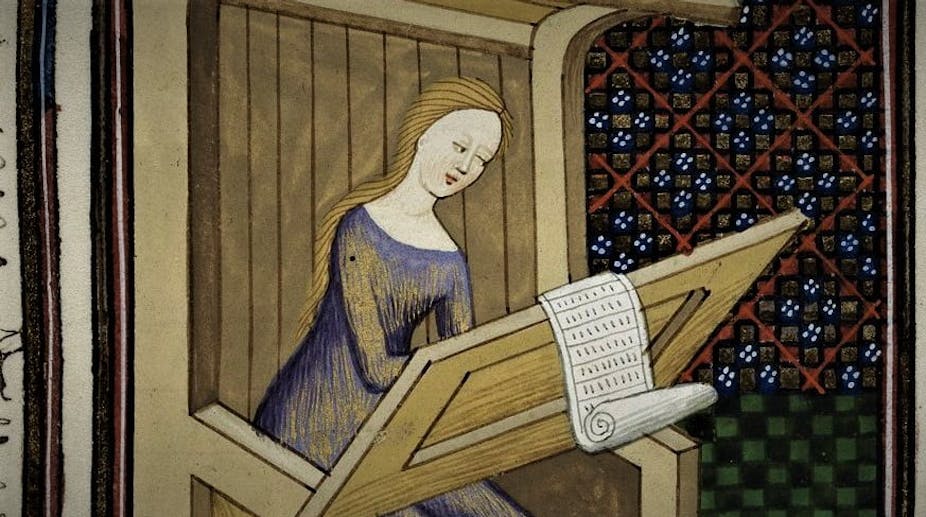Medieval Europe was a place of great emotional incontinence. So much so that historian Johan Huizinga claimed: “Modern man has no idea of the unrestrained extravagance of the medieval heart.”
Crying was ubiquitous – especially by religious men and women, as writing and illustrations in religious texts of the time show. Women were not allowed to engage widely in holy intellectual pursuits such as writing and interpreting religious texts, so they could only channel their religious fervour and closeness to God through their bodies.
But though such displays of extreme emotions were accepted from religious women because it was seen as a sign of their devotion to God, it wasn’t considered acceptable for their lay counterparts.
In the medieval period, prescriptive literature warned women of the dangers of anger – one of seven deadly sins. Women’s anger was seen to confirm their inherent weakness and inability to control their emotions.
But while they were discouraged from expressing their feelings in daily life, letters written by elite women of the medieval period are a rich source of information about their emotions. Most upper-class women were educated and eloquent in their writing, and letters gave them the opportunity to express themselves and wield power, when they had little other means of exerting influence.
Surviving letters
Not many of these letters have survived. One that has was sent by Aline le Despenser, Countess of Norfolk, to the chancellor of England in around 1273. Women did not partake in official communication, so this was unusual. The letter is a masterclass in persuasion. It uses rhetoric such as “dear friendship”, which was mostly only used between male associates. But the countess had to write carefully and mostly stay close to the expected gender norms of appearing to be a decorous, obedient wife – a tight line to navigate.

In Renaissance Italy, the feeling of being powerless was palpable in many of the letters that women wrote. A Corresponding Renaissance: Letters Written by Italian Women, 1375–1650 (2016), by historian Lisa Kaborycha, includes 55 letters written by women of different social status. Through their writing, the women attempt to gain cultural currency, enter the public sphere and assert power.
A letter written by the aristocrat Lucrezia de’ Medici shows that she felt trapped in the roles she was expected to play. She was the older sister of Lorenzo de’ Medici, one of the most powerful Italian statesmen of the time, best known for his patronage of artists such as Botticelli and Michelangelo.
De’ Medici was married off at the age of 13 for a large dowry and brought to her husband’s house five years later. In one of her letters, she says: “Don’t be born a woman if you want your own way.”
The letters by another Florentine women from the same period, Alessandra Strozzi are considered some of the most important insights into political and social life at the time. But equally, they provide an insight into her inner world and emotions throughout her life – from joy and triumph to despair, anxiety, pain and sorrow.
Strozzi wrote long letters because she wanted to, not because she needed to. Following the death of her husband, she chose not to remarry to ensure she remained involved in her children’s lives and worked hard to negotiate beneficial financial and marital collaborations for her sons. She also used shame and guilt to manipulate and coerce her sons, Filippo and Lorenzo, into strategic deals.
In one of her letters she says: “Not seeing any of your children makes me wonder who are they doing all this work for. If they carry on as they are, they will harden their hearts and they’ll keep me in these negotiations for so long that I’ll die.”
Embroidered messages
Embroidery was another way that medieval women could express their emotions. These women used their needles as pens, subverting the traditional notion of female docility by incorporating symbols and messages into their designs.
During this period, embroidery was not just undertaken for practical purposes but was expected from virtuous upper-class women, part of expressing their “true” nature as dutiful and obedient wives and daughters.
Most embroidery pattern books were written by men, and in rejecting the patterns (and sentiments) that were proposed by them, these women exerted power and emotional authority, while treading the line between masculine authoritativeness and female passivity.

In collaboration with noblewoman Elizabeth Talbot (widely known as Bess of Hardwick), Mary, Queen of Scots designed several embroidery and lace patterns. The designs were a way to express her agency and emotions during her captivity.
Her designs were a symbol of her pride and resistance, especially as her letters were under constant surveillance. Her use of colour and symbols showed her grief and melancholy. In one panel, a crowned ginger cat is pictured with a grey mouse, representing her fractious relationship with her cousin, Elizabeth I.
While these letters and embroidered messages are a fascinating insight into the emotions of medieval women, most of them are from women of high social standing who had wealth and privilege. Women from lower classes were not educated, and so could not make use of these forms. And the archives have gaps. What was perceived to be of value has been saved for posterity, while that which did not hold cultural currency was not.
As I discuss in my book, Hysterical: Exploding the myth of gendered emotions, while the wider literature from the period tells us that medieval women were silent and passive, quiet and chaste, their letters and embroideries tell a different story. The women who wrote and created these works were bold and strident, angry and astute. And clever enough to find their own tools for claiming power, in a culture determined to silence them.

Looking for something good? Cut through the noise with a carefully curated selection of the latest releases, live events and exhibitions, straight to your inbox every fortnight, on Fridays. Sign up here.

